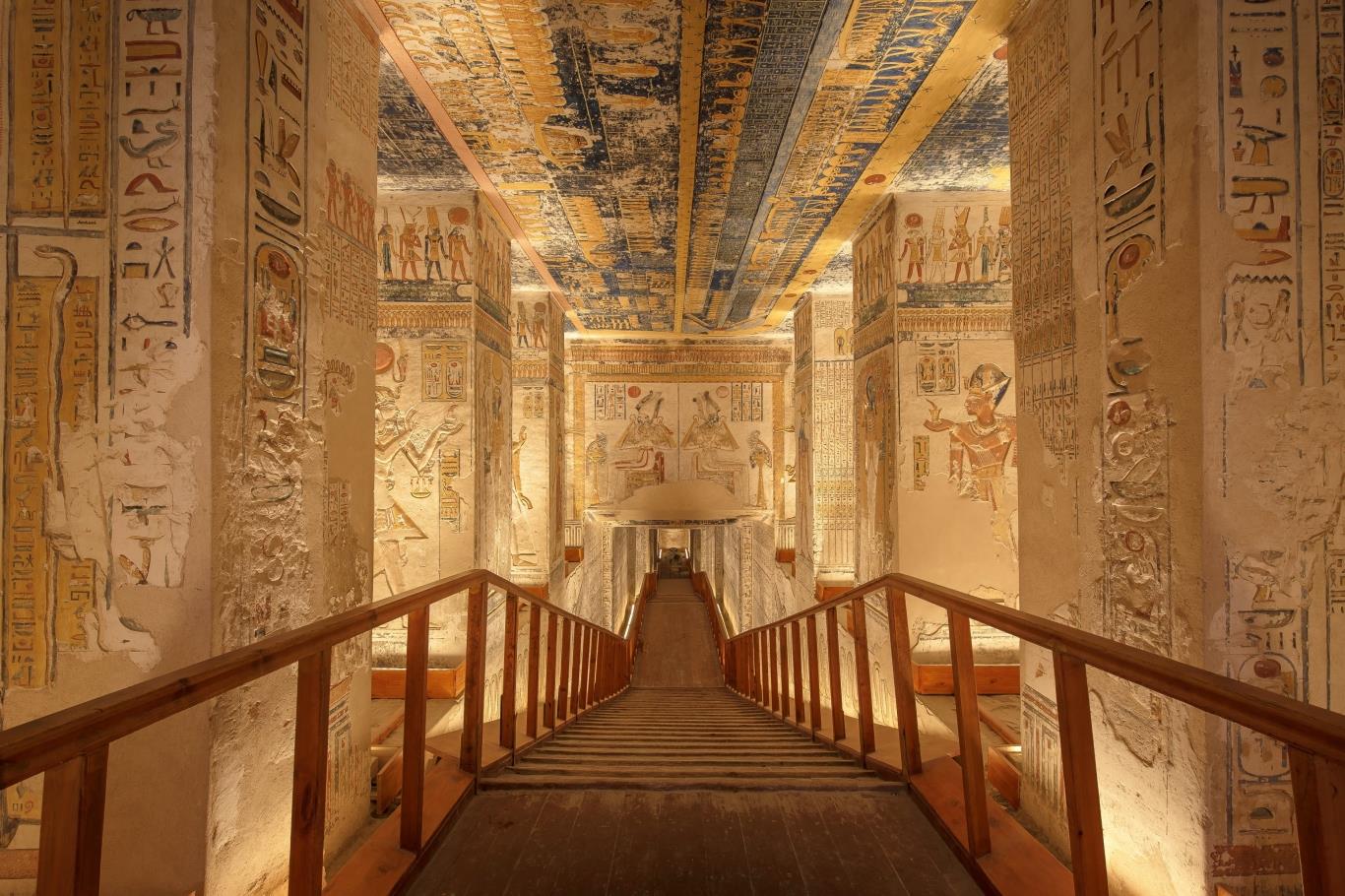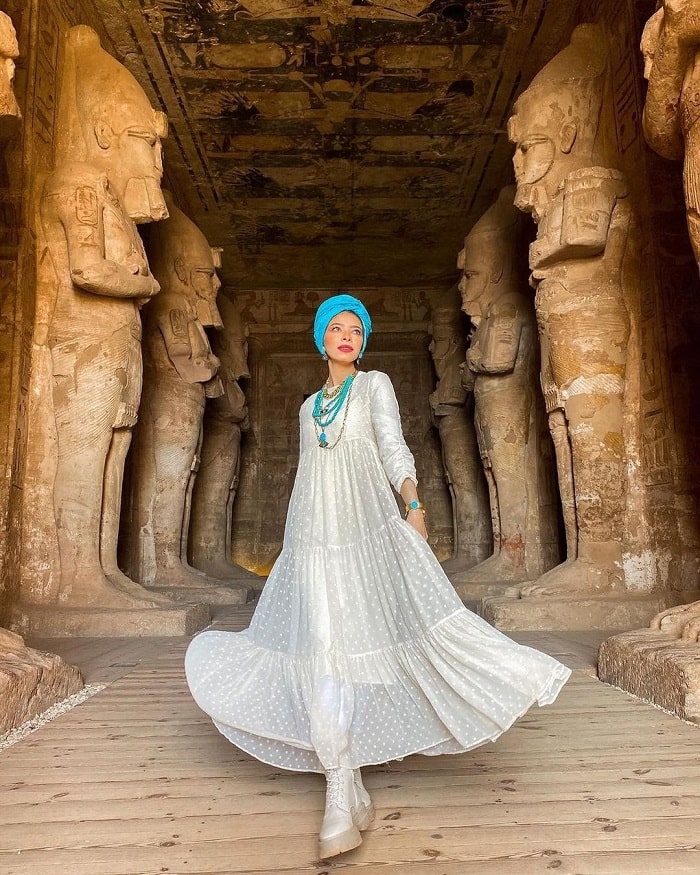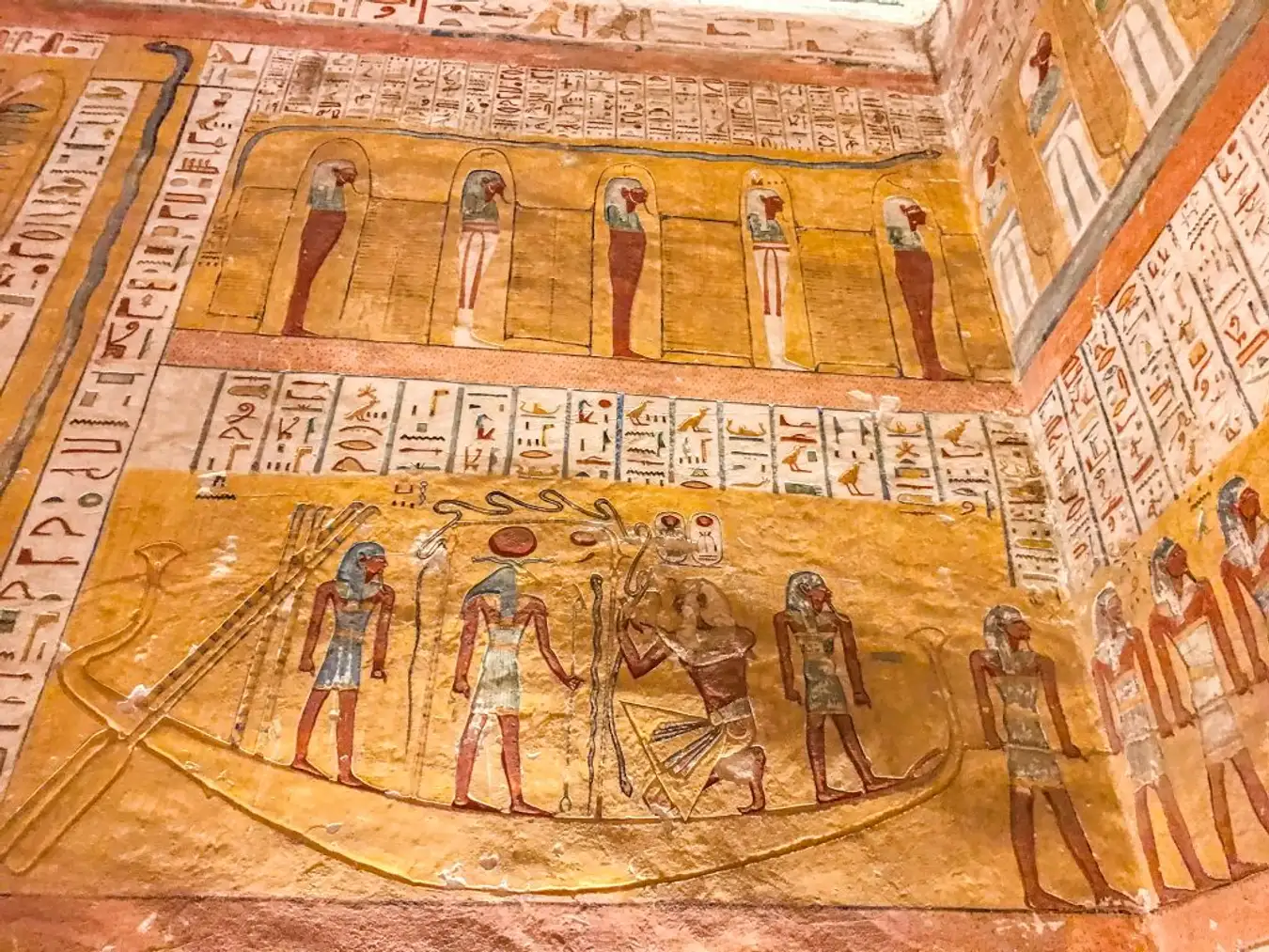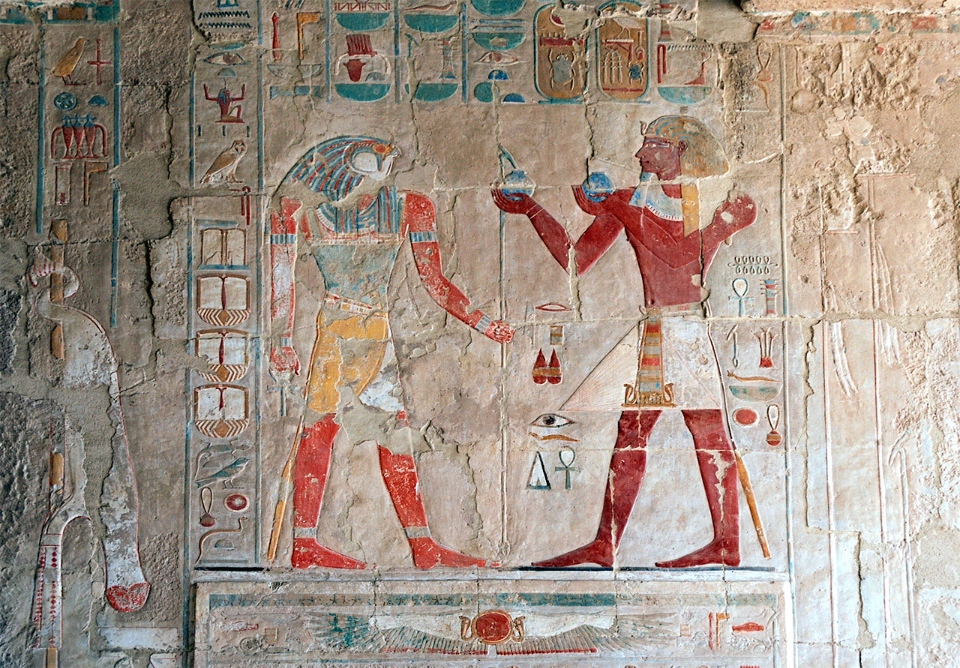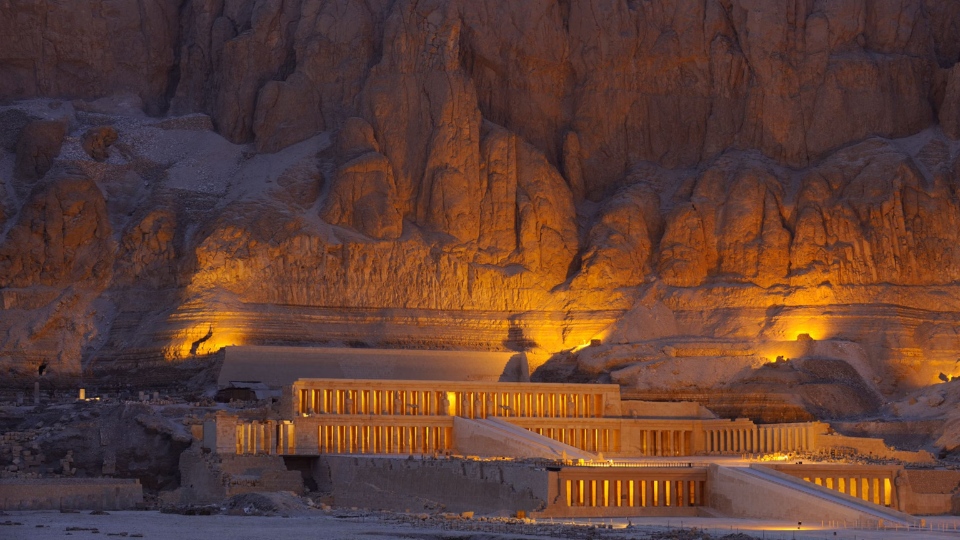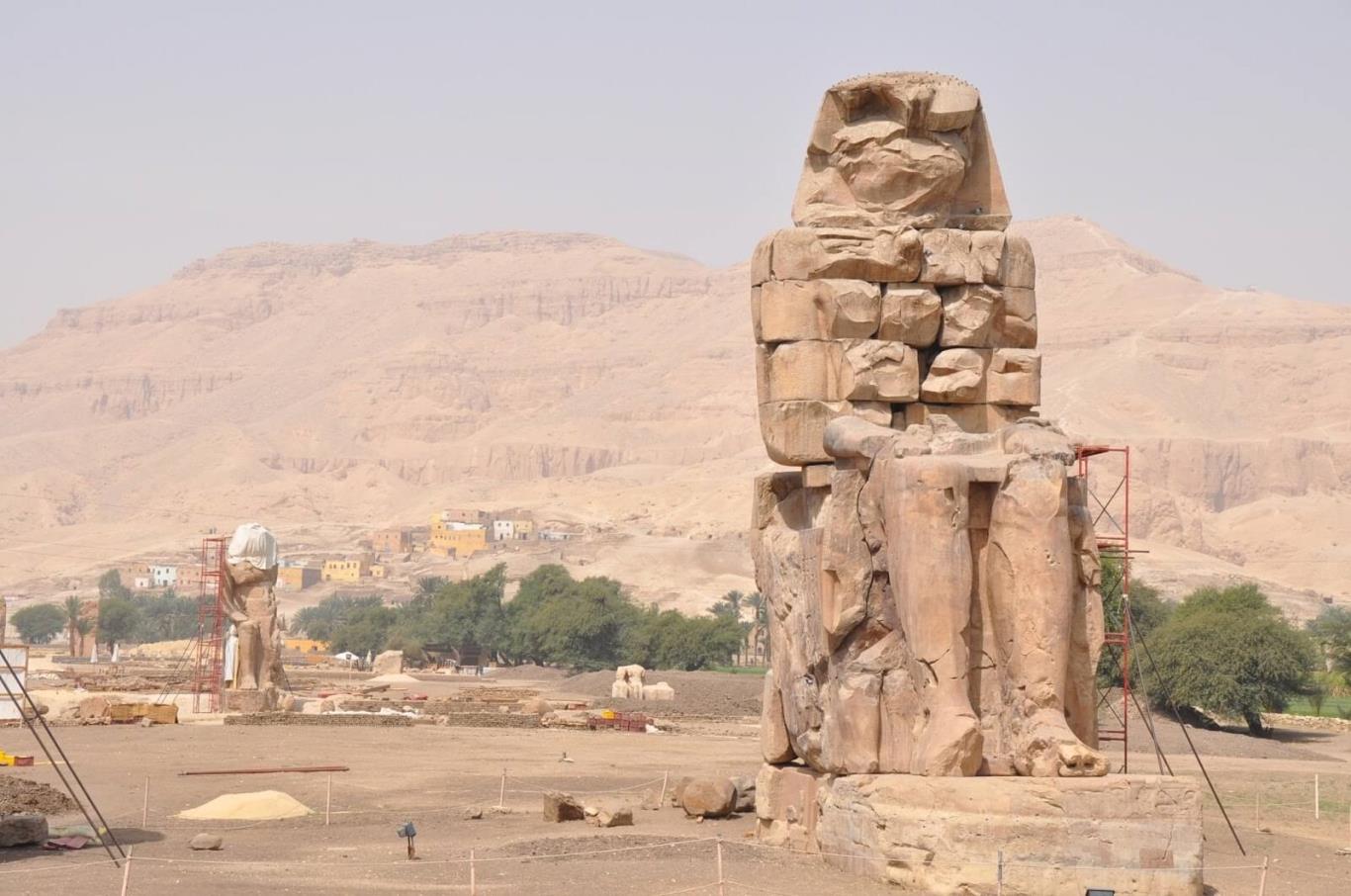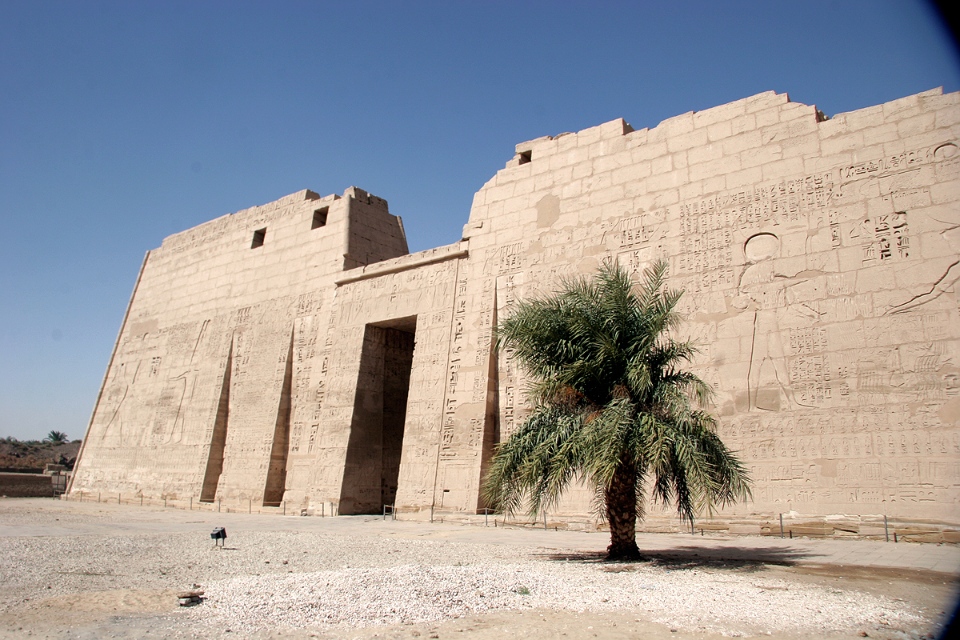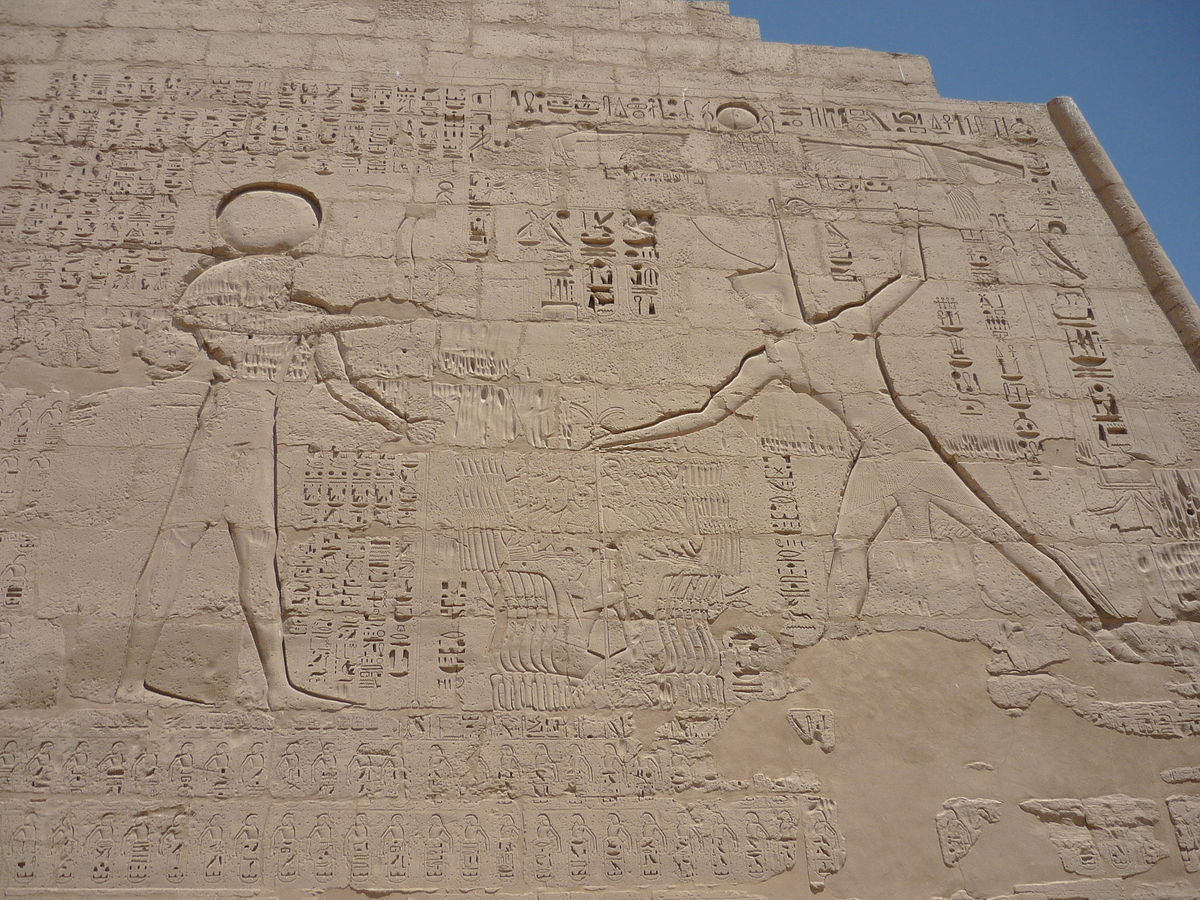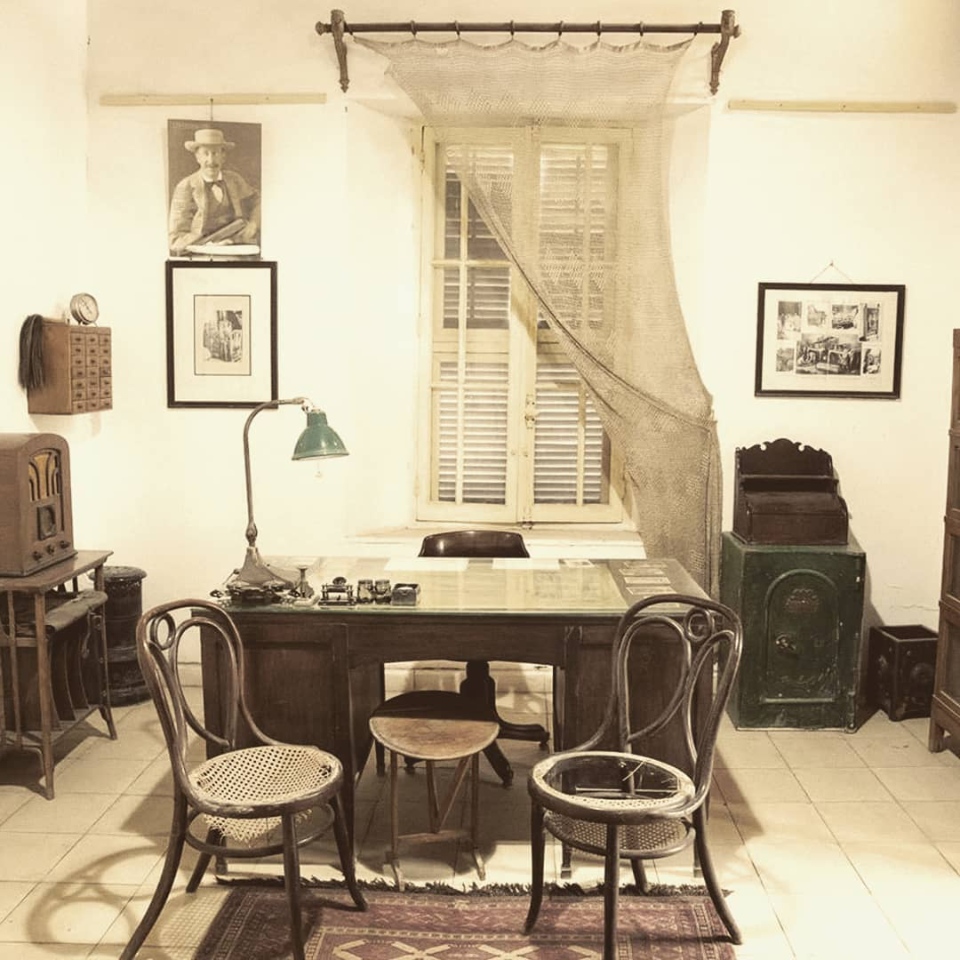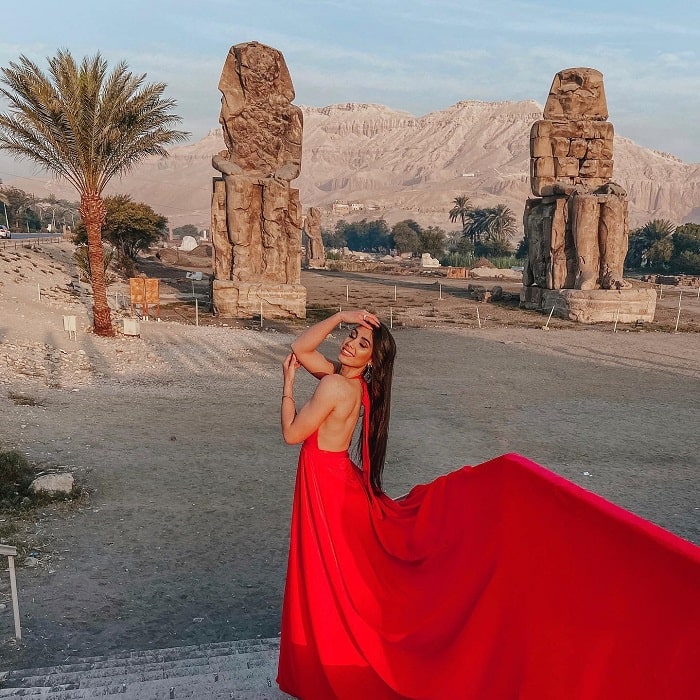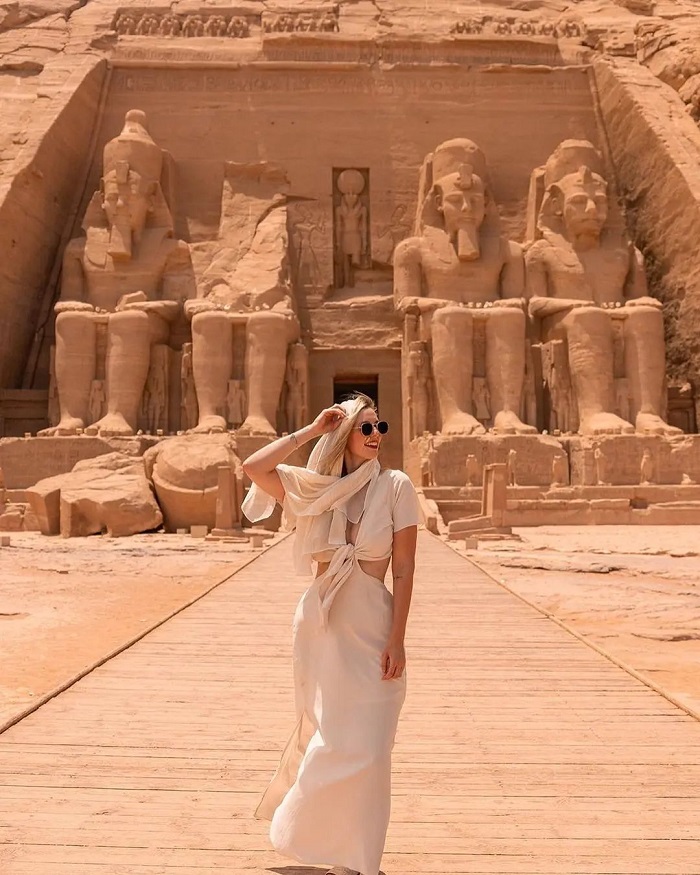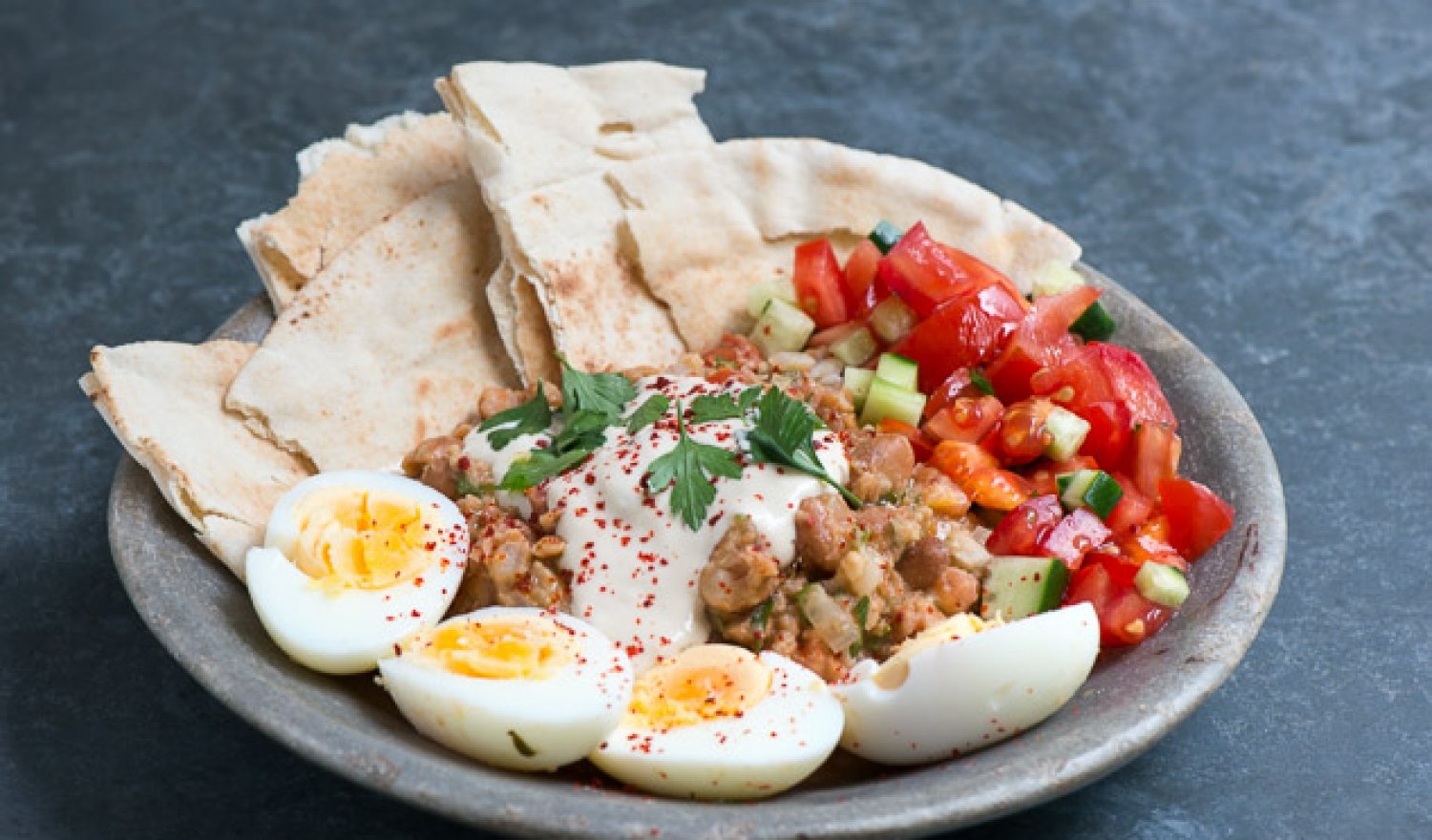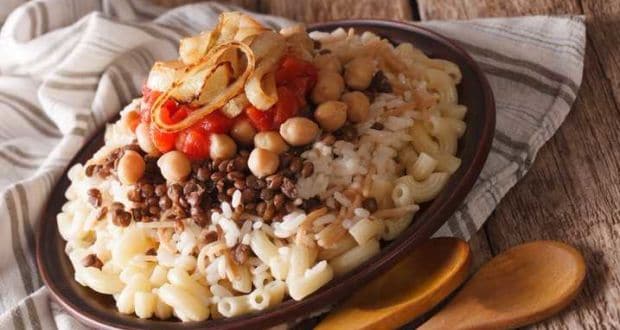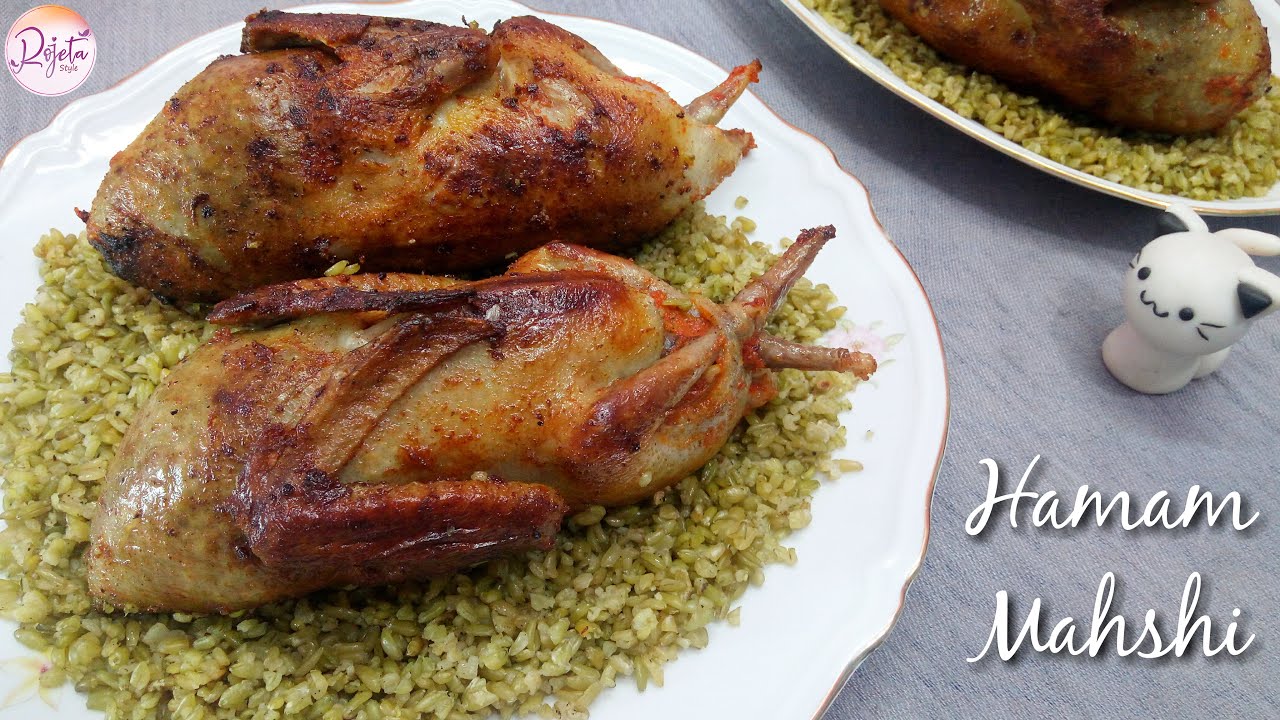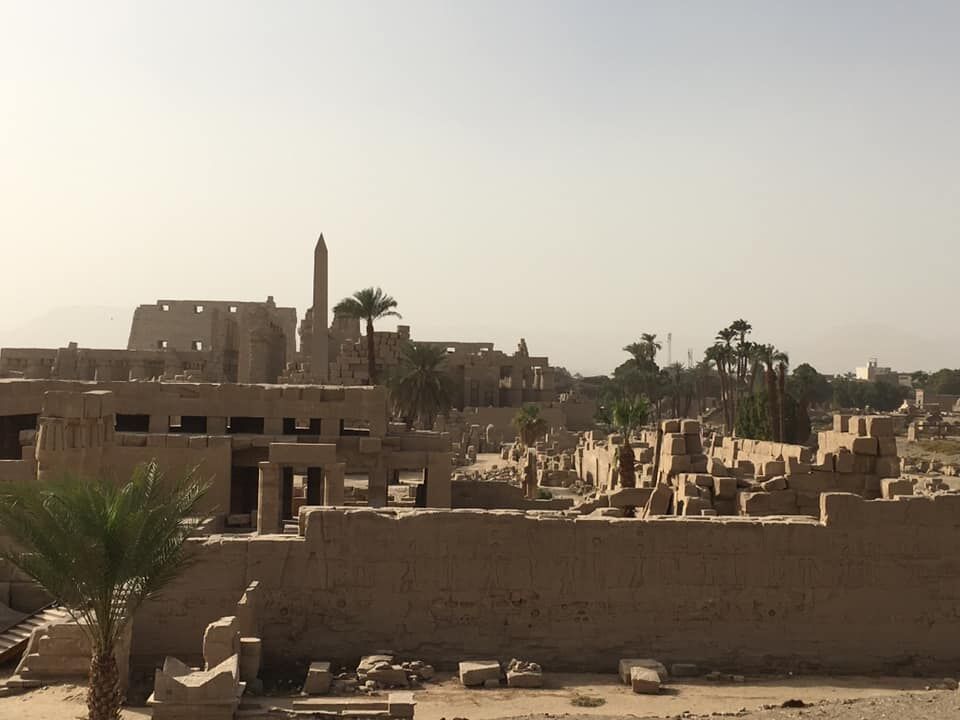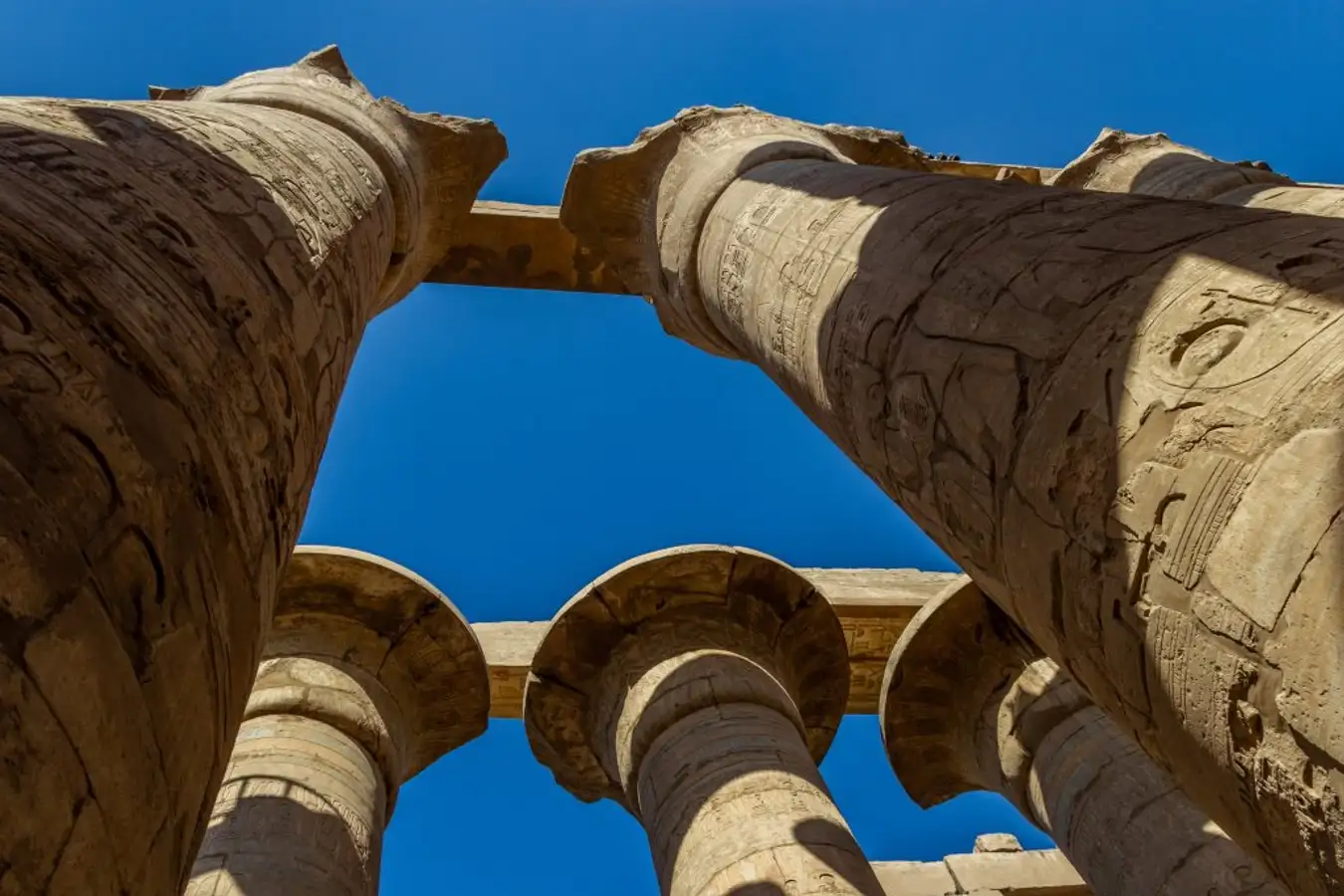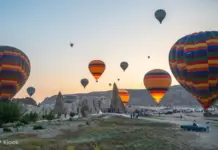Karnak Temple is dedicated to the sun god Amun-Re. The complex was built between 1580-1160 BC by about 30 successive pharaohs. Each king made his own mark on the temple with stone pillars (Obelisk). This is also the main place of worship of the Pharaohs for nearly 2,000 years.
- What to buy in Egypt? — Top 17+ must-have & best things to buy in Egypt
- Cairo travel blog — The fullest Cairo travel guide for first-timers
- Aswan travel blog — The fullest Aswan travel guide for first-timers
- Sinai blog — The quick Sinai travel guide for a journey to the sacred land of Egypt
- The ULTIMATE Uji travel guide: Top attractions, best things to do in Uji Kyoto, Tips & MORE

These columns are probably the largest with many more than 21 meters (69 ft) tall. The fact is that they were able to build such an impressive structure with some sections weighing more than 70 tons in 300 BC.
The Great Hypostyle Hall is one of the highlights of visiting Karnak Temple and it makes a great photo spot if you have a camera with a wide enough focal length to really capture the true scale of these columns . I don’t have one so all I get is a picture of columns and a very small picture.
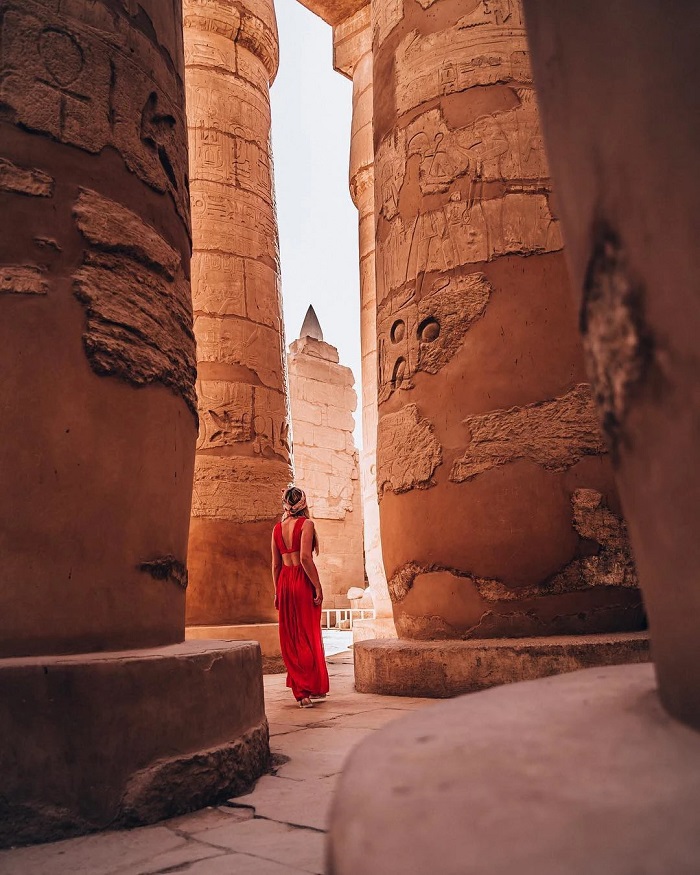
Located in the center of the temple, you’ll also find the Obelisk of Thutmosis I, the tallest in the world at the time it was built, and the tallest surviving ancient tower in the world now a sight to be admire.
The opening hours of Karnak Temple are from 6:00 a.m. to 5:30 p.m. daily, and the entrance fee including the Karnak Open Air Museum is 200 EGP per person. Expect to spend about 1 to 2 hours here to really see it all.
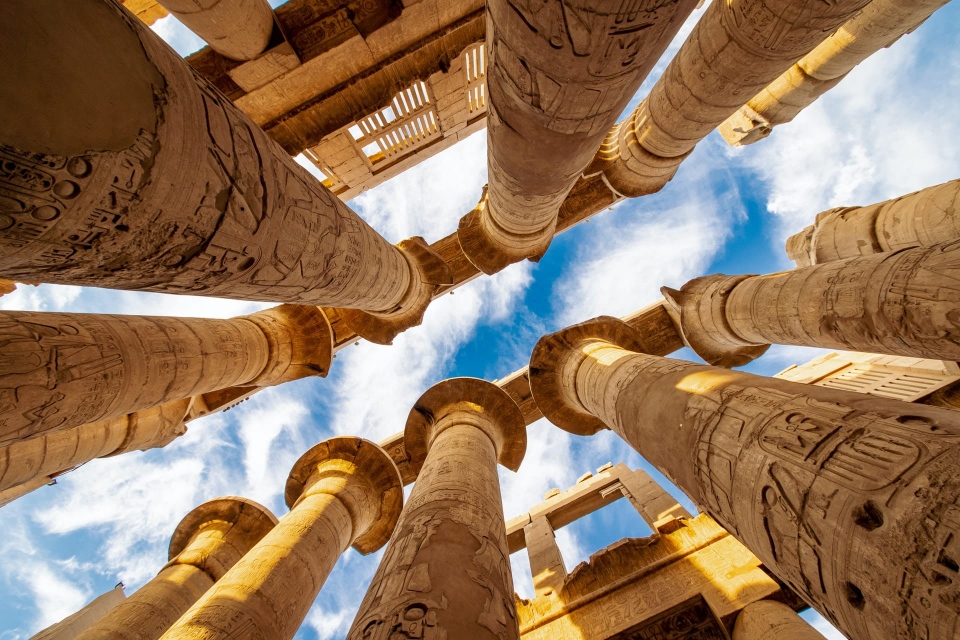
The Karnak temple complex is so large that you need a lot of time to explore (at least a day). Every evening there is a light and sound show about the 1500-year history of the temple’s construction. There are three shows every night and are performed in many different languages. You can buy tickets at travel agencies in Luxor or buy them directly at website www.soundandlight.com.eg
Luxor Museum
Address: PJ5V+2RV, Kornish Al Nile, Luxor City, Luxor, Luxor Governorate 1362503, Egypt
Hours: 9 AM–4 PM, 5–10 PM
Located on the East Bank of Niles, the Luxor Museum is where they collect and preserve the ancient Egyptian artifacts discovered in Luxor from everyday objects to ancient sculptures, and even mummies.
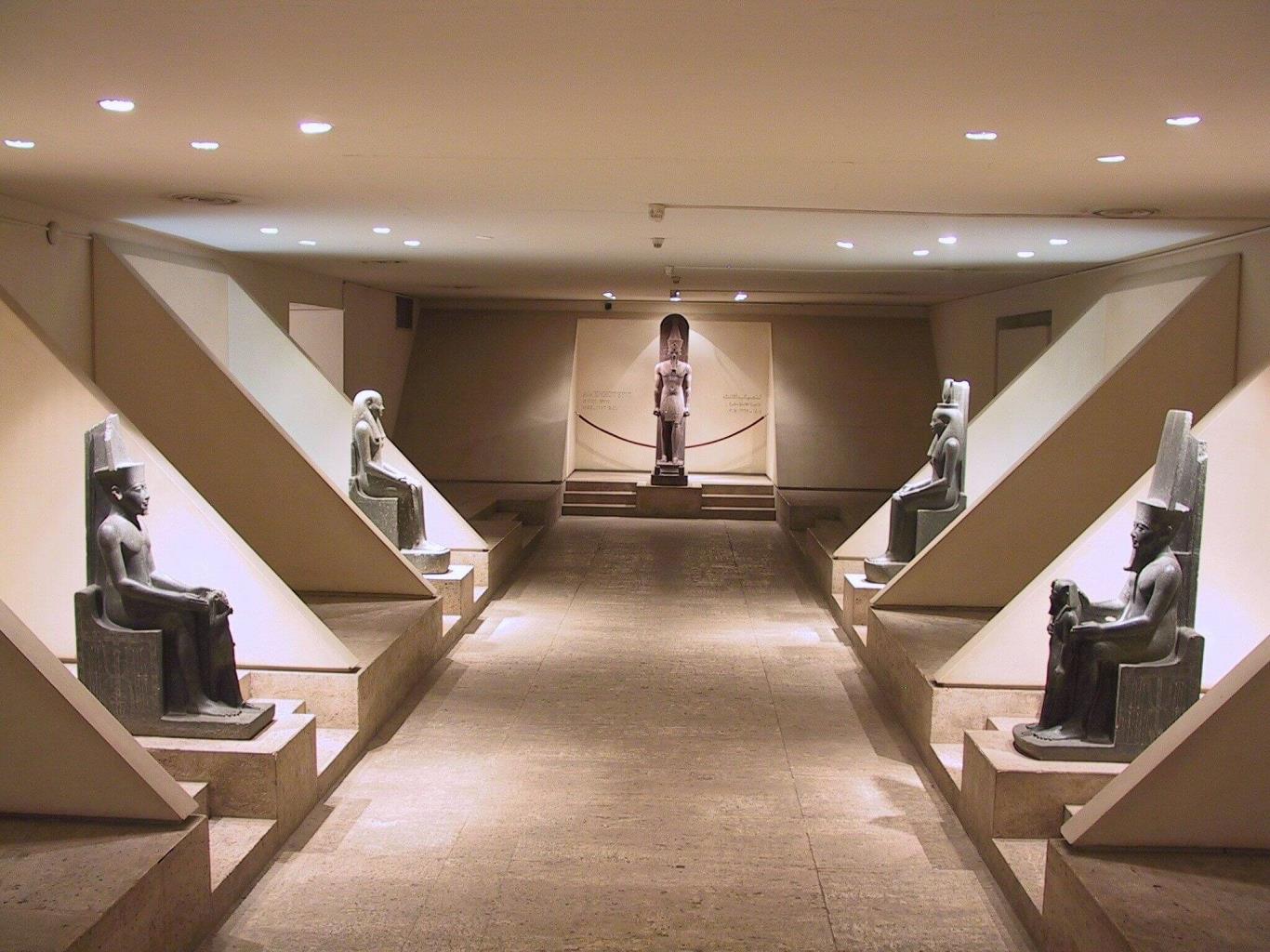
With countless rare and valuable artifacts discovered in Luxor, in 1962 the Egyptian Ministry of Culture assigned the leading Egyptian architect, engineer Mahmud Al-Hakim to design the architecture for Luxor Museum and it officially opened on December 12, 1975. Luxor Museum displays artifacts collected from Thebes (ancient Luxor) and Necropolis, the Valley of the Kings. Famous artifacts include the statue of King Tuthmosis III of the 18th dynasty (1490–36 BC) made of green slate, discovered in 1904 in the Karnak temple reserve; the statues of Sobek and King Amenhotep III are made of limestone… Most of the antiques in the museum have signs in English for you to find out.
The museum houses a beautiful collection of items that tell the story of what life was like in ancient Thebes. One can only imagine what they have discovered in this “land of palaces” and how many are still waiting to be discovered.

If you are looking to learn more about this ancient Egyptian city, a visit to the Luxor Museum is unquestionable. The museum is open from 9 a.m. to 4 p.m. and reopens from 5 p.m. to 10 p.m. daily. The entrance fee is 140 EGP/person.
Ramesseum Temple
Address: Edfo, Luxor Governorate 1341711, Egypt
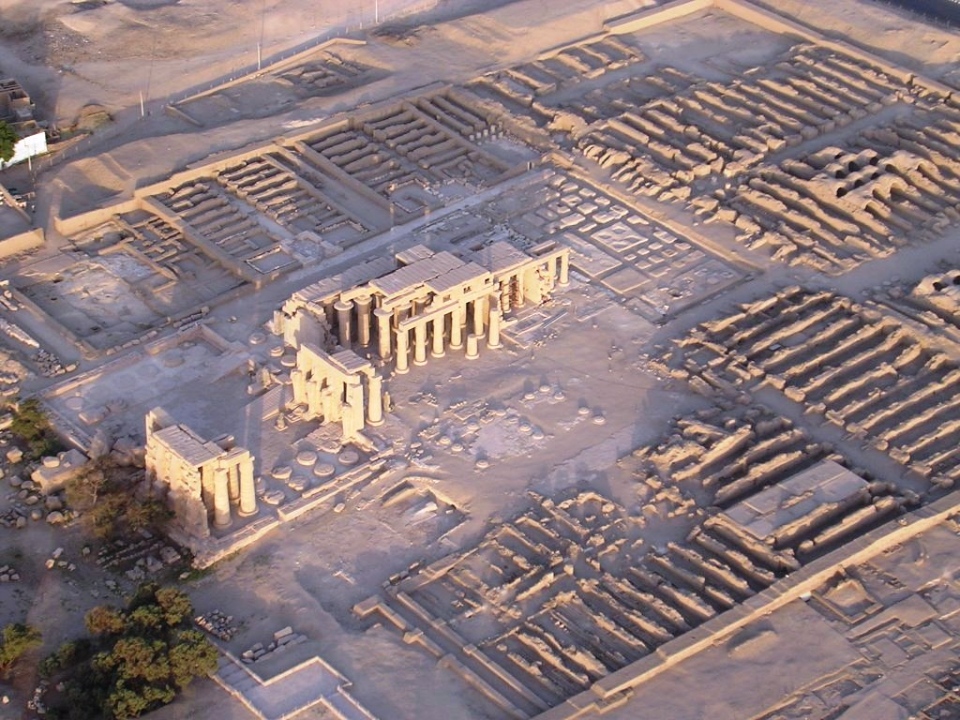
You also can’t miss the Ramesseum temple ruins. Ramesseum is a place dedicated to pharaoh Ramses II and worshiping the gods. The temple was designed according to the majestic ancient Egyptian architecture including: main buildings, two huge entrance stone pillars, the legendary Hypostyle corridor. Adjacent to the north side of the Hypostyle Corridor is a smaller temple dedicated to Ramses’ mother and queen Nefertari. The south is a complex of palaces, temples, granaries, and workshops to serve the pharaohs.
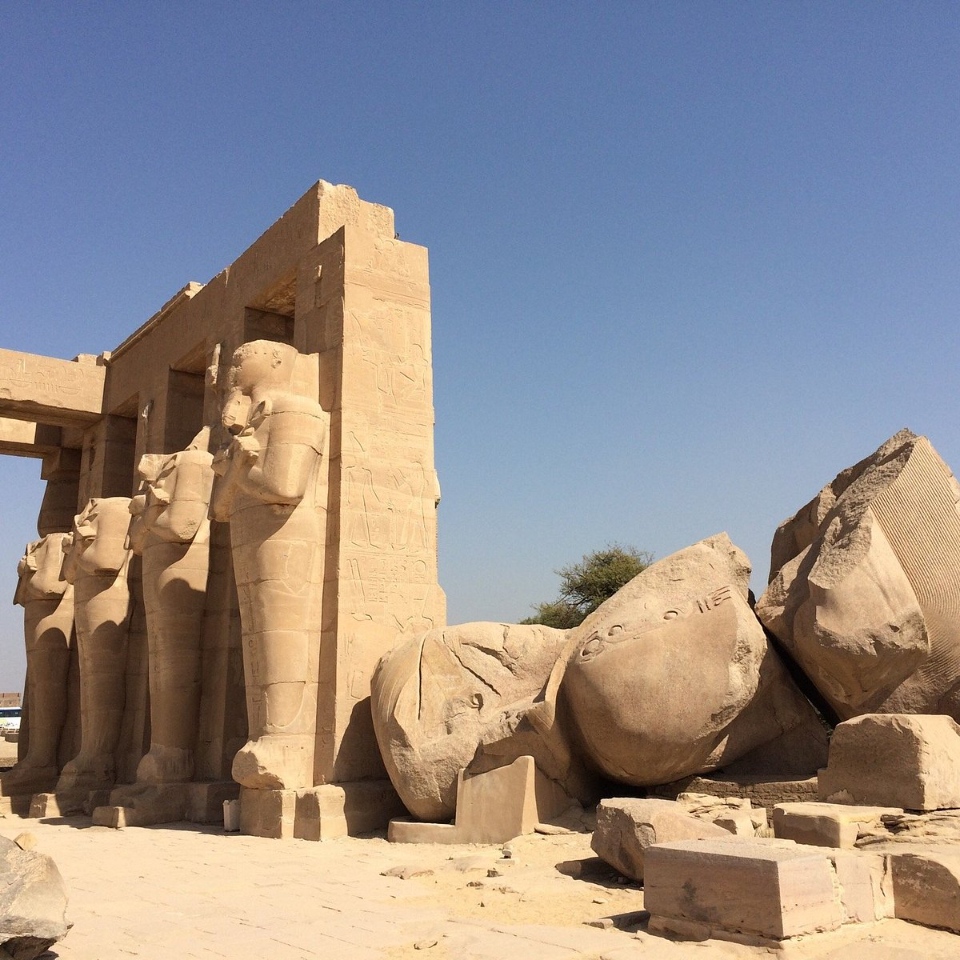

Mummification Museum
Address: ش Kornish Al Nile, Luxor City, Luxor, Luxor Governorate 1362501, Egypt
Hours: 9 AM–1 PM, 5–8 PM

The Mummification Museum is another museum located not too far from the Luxor Museum and Luxor Temple, well worth a visit if you are interested in the mummification process or how the ancient Egyptians mastered the art of preserving the dead.
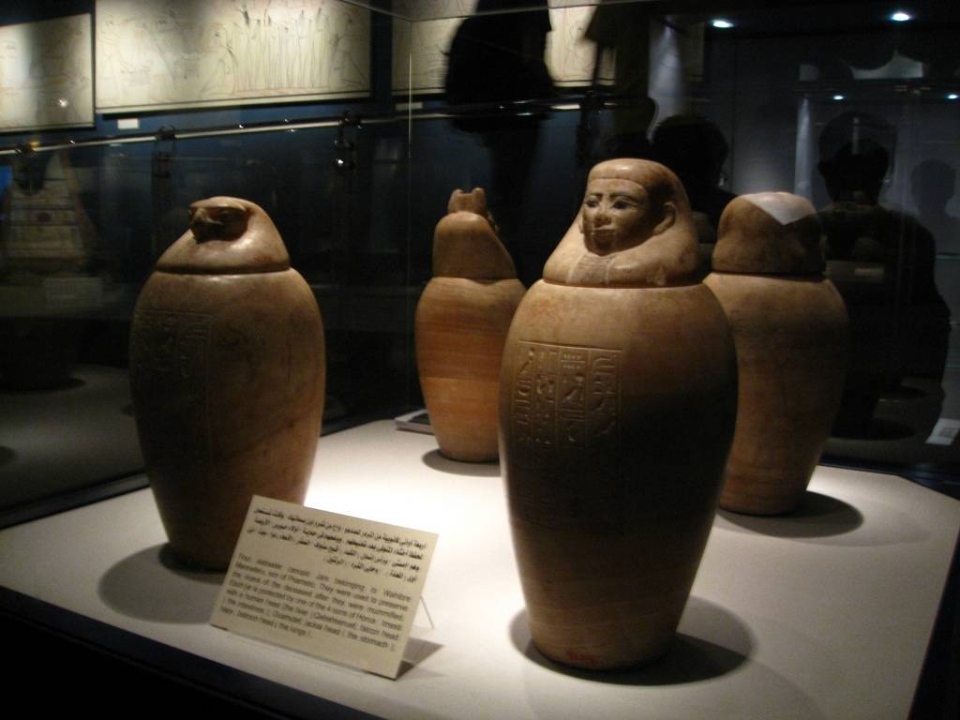
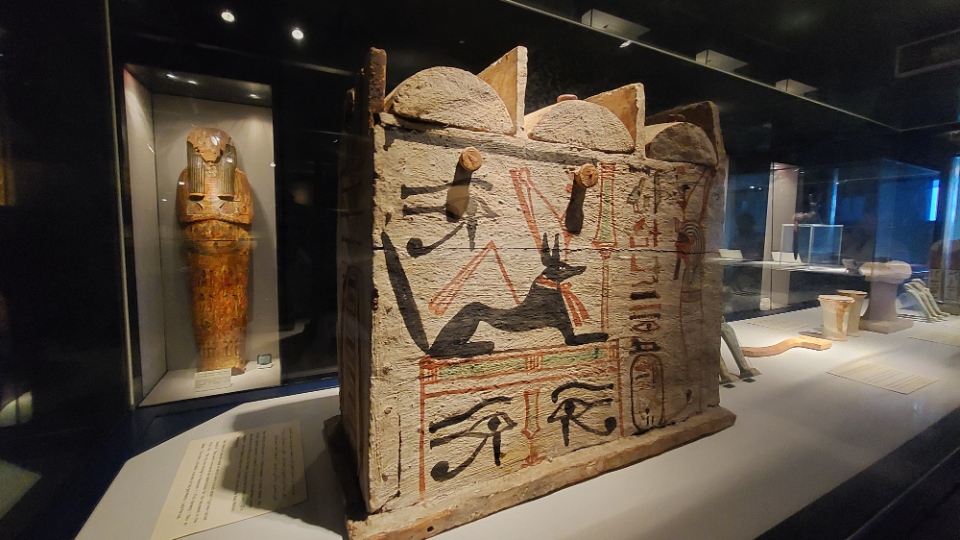
The museum is not as big as the Luxor Museum but still a pretty interesting place to visit if you have an extra day to spare in Luxor. The museum is open from 9 am to 1 pm and reopens from 5 pm to 8 pm daily and the entrance fee is 100 EGP per person.


Valley of the Kings
Now that we’re done with the East bank of Nile, it’s time to explore Luxor’s West Bank and one of the first places you must visit is the Valley of the Kings. This valley is the burial place of many ancient Egyptian pharaohs. Among the more than 60 royal tombs is the famous Tomb of Tutankhamen which was found in intact condition.

In particular, Luxor also has an extremely famous place that you cannot help but visit, which is the valley of the kings, which attracts thousands of foreign tourists every year. This valley is the resting place of kings, queens and descendants of kings. This valley dates from about 1539 – 1075 BC. Currently, archaeologists have surveyed this valley containing about 60 Pharaoh tombs and many other aristocratic tombs starting from the time of Pharaoh Thutmose I to Pharaoh Ramses XI.

The special thing in this valley is that each tomb discovered in the valley of the kings has unique and sophisticated architecture through different periods, creating a special attraction for archaeologists or tourists. guests who love to explore. The tombs are a perfect architectural complex including auxiliary works such as dining room, living room… with the belief that there is life in the afterlife after death.
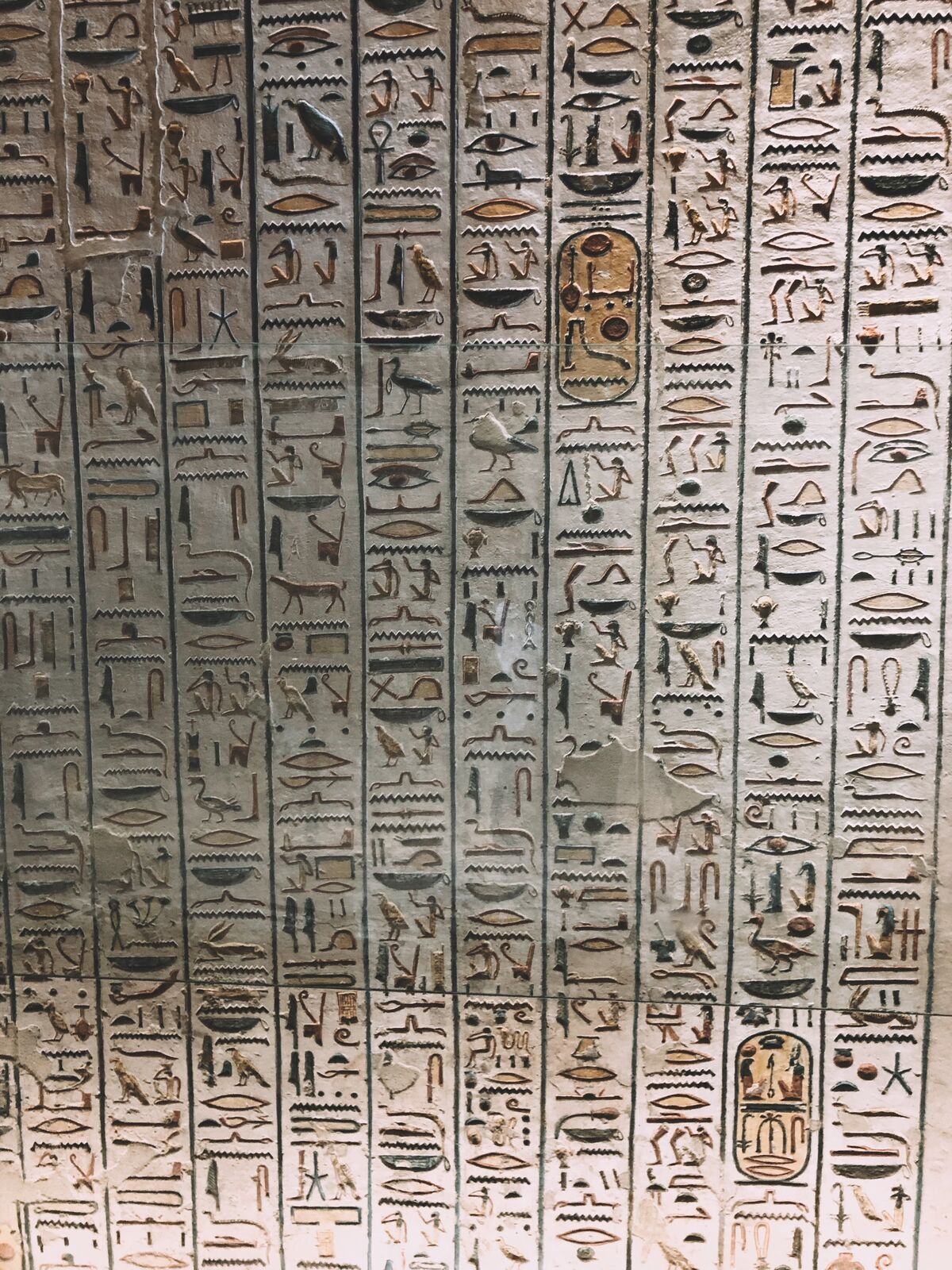
Not only was it a place to bury Pharaohs, it was also a place to bury powerful people in the new dynasty (New Kingdom – from 18th dynasty to 21st dynasty in ancient Egyptian history). The tombs are carved deep into the limestone mountains, located several tens of meters underground. The entrance to the tunnel was very small, forming a long corridor that gradually sloped downwards. The middle of the corridor is one or more large rooms. Through the middle section, the corridor continues to run downhill to the resting place of Pharaoh. The inside of the tomb is decorated with vivid frescoes whose colors are still fresh after several thousand years as shown in the pictures. Gods, pharaohs, ancient scripts, legends related to death and resurrection…
More than 60 tombs and chambers have been found in this valley, many of which are decorated with carvings and murals of scenes from Egyptian Mythology, allowing us to learn a little more. A little bit about the beliefs of the ancient Egyptians.
Some of the most impressive royal tombs in the Valley of the Kings are the tomb of Tutankhamun, the tomb of Ramesses V and Ramesses VI, and the tomb of Seti I, all of which require additional admission tickets.
I especially like the tomb of Ramesses V and VI where you will be able to see some of the best preserved colored wall carvings still intact and if you intend to spend 100 EGP for extra tickets.
King’s Valley is open from 9am to 3pm every day except Friday and Sunday. The entrance fee to the Valley of the Kings is 240 EGP per person and you can enter 8 tombs. To enter the tomb of Ramesses V and VI, you will have to spend an additional 100 EGP for an extra ticket.
The Valley of the Queens is located southwest of the Valley of the Kings, where the tombs of Pharaoh’s wife and children are located. This place is mainly a mausoleum from the 19th dynasty, of the 80 tombs the most famous is the tomb of Queen Nefertari.
Mortuary Temple of Hatshepsut
Address: Al Qarna Desert, Luxor Governorate 1340420, Egypt
Hours: 6 AM–5 PM
Hatshepsut was the first female Pharaoh of the Egyptian civilization. She is one of the longest-reigning female pharaohs in ancient Egyptian history. Hatshepsut built Thebes to flourish and prosper during the 18th dynasty, resuming a trade network that had been interrupted during the Hyksor’s occupation of Egypt.
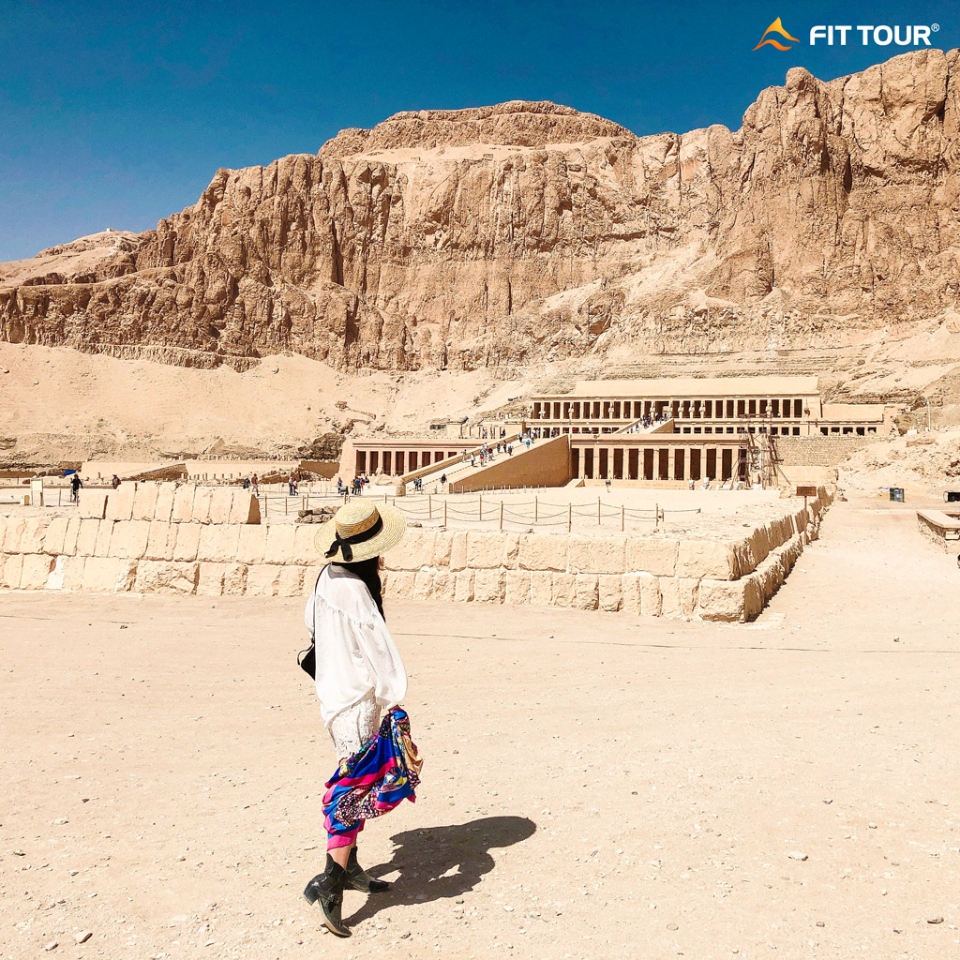
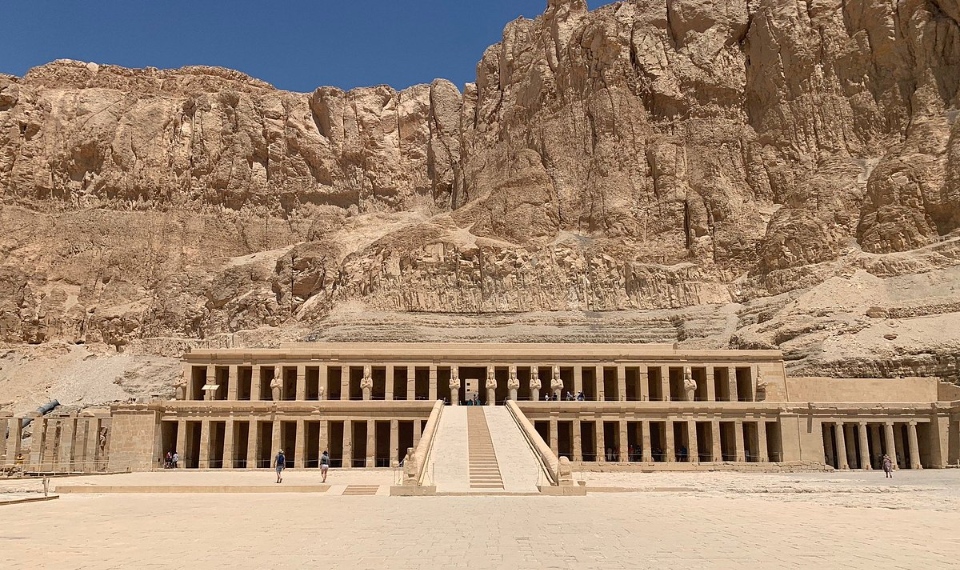
She also led successful military campaigns in Nubia, Syria and the Near East that made Egypt so powerful at that time. Hatshepsut Temple has a completely different architecture compared to the rest of the temples in Egypt, it is bold Roman architecture (shown at the columns). The temple rests on the mountain and overlooks a vast expanse in the Valley of the Kings, three spacious and majestic levels leading to a shrine dedicated to the gods Hathor and Anubis. In the main hall is a row of statues of Queen Hatshepsut in the costume of a powerful Pharaoh with crossed hands holding a staff and the key to life, crowned on her head.
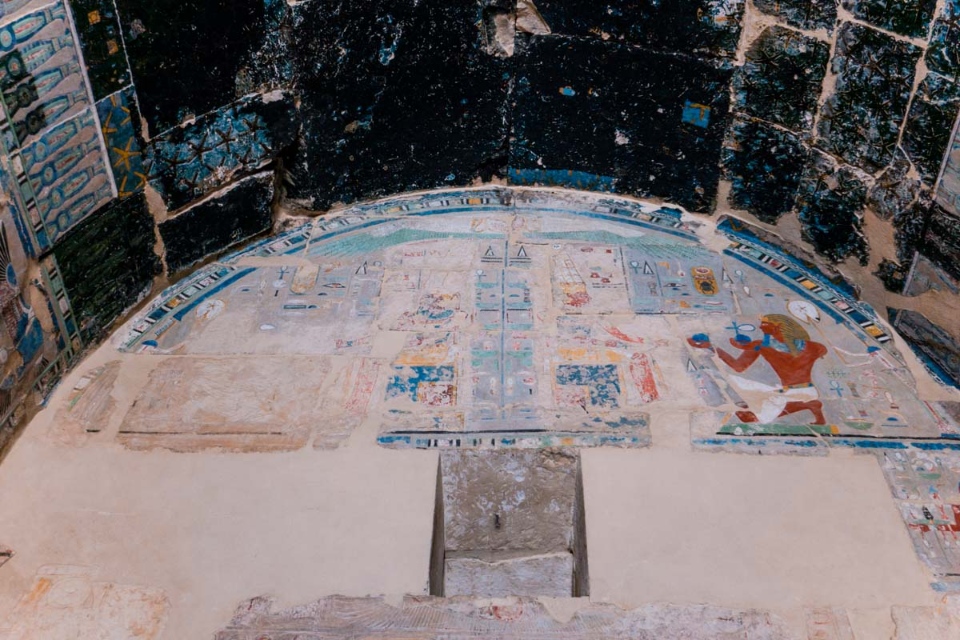
One of the most famous temples in Luxor is Hatshepsut Temple. This is the temple of the only female Pharaoh of Egypt, Hatshepsut. The temple has extremely sophisticated and unique architecture. Not only attractive by the architecture here, but this temple is a symbol of social, gender and class equality in the old regime.
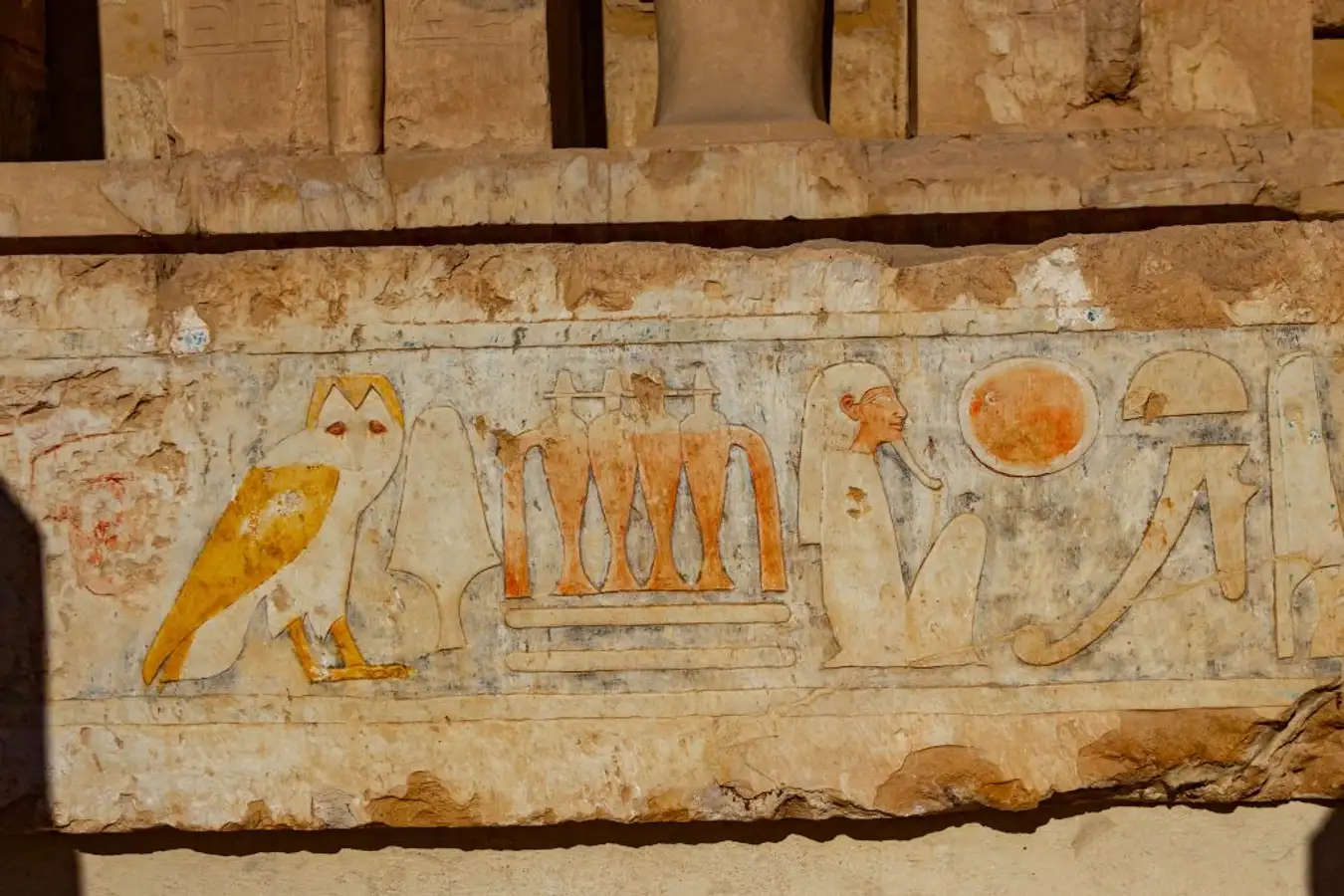
The temple consists of 3 massive steps jutting out into the desert that take you to several temples within the cliffs behind it. There are some really impressive columns and carvings to see once you get inside. The place is quite big and it can take you an hour to see all it has to offer.
The temple is open from 6 am to 5 pm daily and the entrance fee is 140 EGP per person.
Colossi Of Memnon
Address: Al Qarnah, Al Qarna, Luxor Governorate 1341703, Egypt
Hours: 6 AM–6 PM
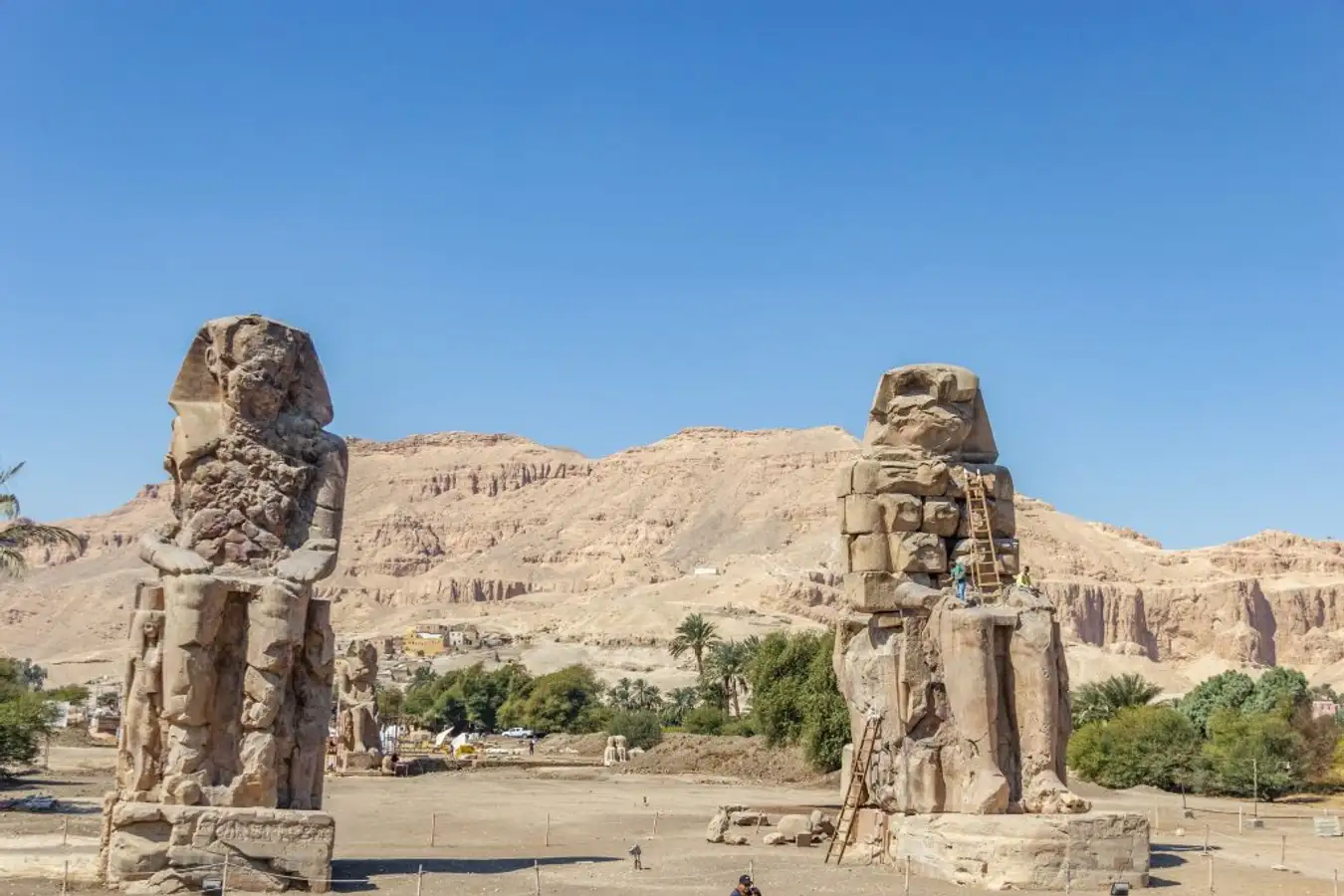
The Colossi of Memnon are 2 colossal stone statues of the pharaohs about 18 meters (60 ft) high and it is said that these statues have stood in this exact spot since 1350 BC when they was built.
The double-faced statue represents Pharaoh Amenhotep III, the king who ruled the Egyptian empire during the 18th dynasty. The statue is nearly 3400 years old, about 18m high. Two stone statues in a sitting position, hands on knees, faces towards the Nile. Initially, the statue was at the gatekeeper of the Amenhotep temple – which was built when the pharaoh was still alive. However, later the temple was destroyed, only two giant statues remain to this day.
The Colossus of Memnon are two large stone statues of Pharaoh Amenhotep III, who ruled in Egypt during the XVIII dynasty. The two statues depict Amenhotep III in a sitting position, his hands resting on his knees and his gaze directed towards the river.
The fact that the sculptures are 3000 years old really shows how much the ancient Egyptians were masters of builders.
This place is open from 6am to 5pm daily and free admission!
Medinet Habu (Ramesses III Temple)
Address: PJ92+PGG, Al Bairat, Al Qarna, Luxor Governorate 1340550, Egypt
Hours: 6 AM–5 PM
Not too far from the Colossi of Memnon, there is also another impressive temple to visit. The Medinet Habu temple is an ancient temple dedicated to god Amun, and it is famous for its well-preserved inscriptions depicting the defeat of the Seamen during the reign of Ramesses III on the temple walls.
In the temple you will also find several courtyards with some really impressive ancient Egyptian sculptures, pylons and columns, similar to those in Karnak Temple but smaller.
The temple is open from 6 am to 5 pm and the entrance fee to Medinet Habu is 100 EGP per person.
Howard Carter House
Address: Kings Valley Rd, New Valley Governorate 1340604, Egypt
Hours: 9 AM–4 PM/Friday: Closed
For those of you who are traveling the West Bank of Luxor, don’t forget to visit the Howard Carter House, the preserved house of a great British archaeologist who discovered Tutankhamun’s Tomb in the Valley kings in the 30s.
All the items of the house is kept as it was almost 100 years ago and visiting this place, seeing all the old furniture, you feel like you are stepping back in time. The house is open from 9 am to 5 pm every day and the entrance fee is 20 EGP.
How many days should you spend in Luxor?
One day is enough to see most of what Luxor has to offer or you can extend your stay to 2 days if you want to relax a bit. Here is the rough itinerary for Luxor:
Day 1: Take a day trip and visit all the tourist attractions in the East and West Banks of Nile. Spend the evening at Luxor Temple for a stunning sunset experience.
Day 2 (optional): Take a hot air balloon ride in the morning, visit all the museums in the city, and spend the rest of the day relaxing.
How much money do I need for my Luxor trip?
With the rough itinerary above, we can calculate roughly how much you’ll spend here as follows:
- Accommodation: For 2 nights in Luxor, you can expect to pay around 12 USD for accommodation.
- Food: Meals are about 30 EGP on average per meal, so you could expect to pay around 90 EGP for one person for the whole day.
- Transportation: Since it will be cheaper to rely on an organized tour, it will cost you 2 EGP for transportation.
- Activities: For a day trip to Luxor’s East and West banks, you can expect to pay around 80 USD, which will include everything from transportation to entrance tickets and more. If you want to go hot air balloon, it will be more than 30 USD but it is completely optional and you will have to spend another night in Luxor.
Total budget for 1 day in Luxor, Egypt: about $105.
Where to stay in Luxor?
The Nile River divides Luxor. The city is located on the East bank, however most of the attractions are located on the West Bank. If you want to live in the vibrant downtown area, with many restaurants and bars, convenient for traveling, you should stay on the East bank, if you want to be in a quiet place with fewer people, choose the West bank. On famous booking websites such as Booking, Agoda… there are many types of rooms from budget to luxury for your reference.
Bob Marley house Sherief hotel is a hostel that is quite popular with backpackers on the East bank because of its central location, cheap price and friendly staff. On the west bank, there is Luxor Guest House located on the bank of the Nile, but right next to the ferry terminal, so it is very convenient to move.

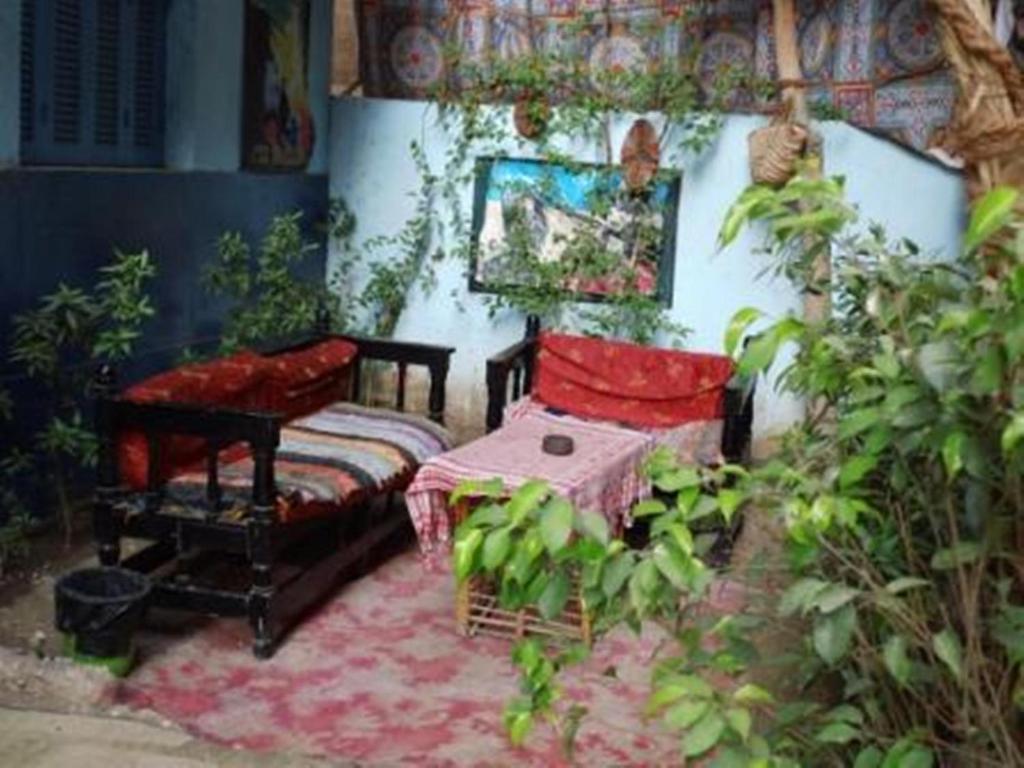

Cheap and includes breakfast too. Hostel also has a very chill terrace. The owner is very enthusiastic to guide you with all the information you need. You can book a day tour and a ballon tour at the hostel.
Below we recommend more best budget, mid-range and upscale hotels with good ratings and reviews you can refer to.
- Steigenberger Nile Palace Luxor – Convention Center (Agoda, Booking)
- Sonesta St. George Hotel – Convention Center (Agoda, Booking)
- Sofitel Winter Palace Luxor (Agoda, Booking)
- Nefertiti Hotel Luxor (Agoda, Booking)
- Hilton Luxor Resort & Spa (Agoda, Booking)
- Pavillon Winter Luxor (Agoda, Booking)
- Steigenberger Resort Achti (Agoda, Booking)
- Pyramisa Hotel Luxor (Agoda, Booking)
- Susanna Hotel Luxor (Agoda, Booking)
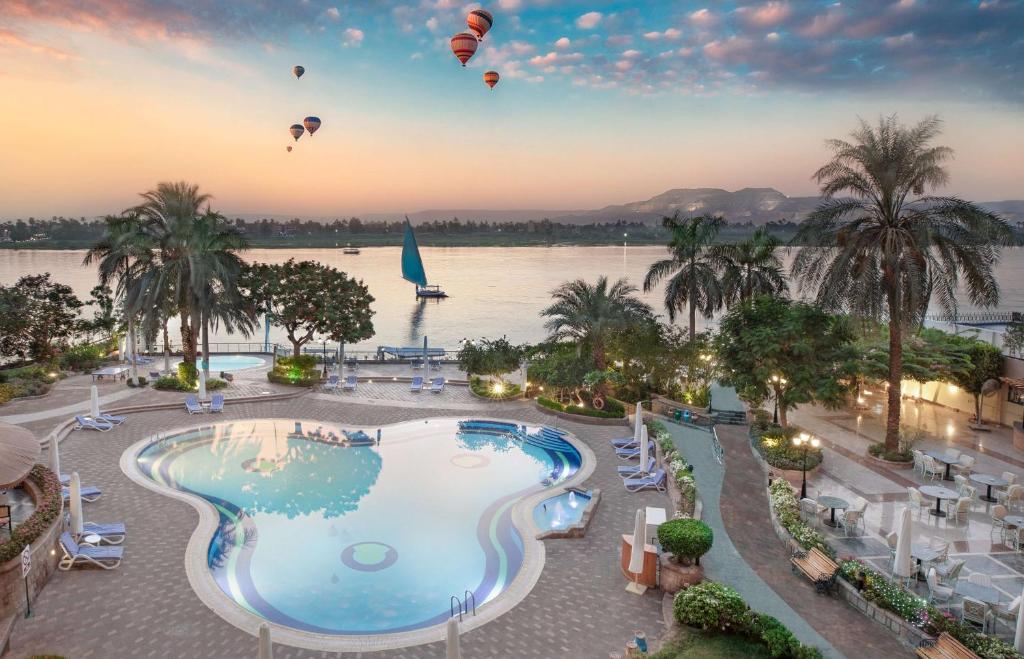
Check out more top and best hotels in Luxor on Agoda.com or Booking.com
What and where to eat?
Bread
In Egypt, bread is a famous traditional food not only in the city of Luxor but also throughout the country. People here can process all kinds of other dishes to use with bread such as ground beef, grilled lamb… In particular, the bread at Luxor has attractive and special versions so visitors can enjoy when it’s hot or cool, small or large, different colors feel strangely delicious. When traveling to Luxor, do not miss this dish.
Ful Medames
Ful medames is one of the famous Egyptian dishes, consisting of fava beans cooked with spices and olive oil. Dried beans are usually cooked overnight, served with eggs and pita bread.
Usually, Ful medames are served for breakfast, but diners can still eat at any time of the day. You will find this dish in small shops or in restaurants serving local and middle eastern dishes.
Fattah
In Egypt, fattah is often served on special occasions such as celebrations and religious festivals. This dish consists of layers of fried bread and rice, topped with vinegar, tomato sauce, garlic butter and beef, veal or lamb.
Kushari
Kushari is a very famous dish in Egypt, available in most restaurants in Cairo as well as across cities. This dish consists of rice, pasta, and black beans cooked with tomato sauce, garlic vinegar and chili.
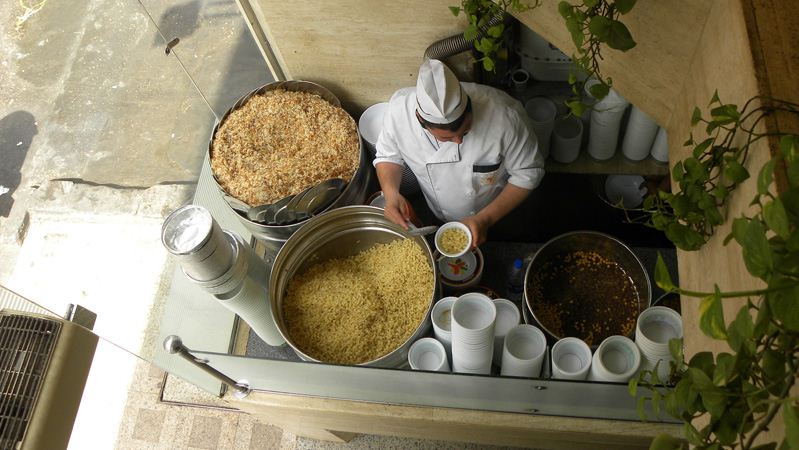
The most attractive feature of kushari is the perfect blend of spices that makes diners can eat forever. This dish is also suitable for vegetarians because the ingredients are all vegetables.
Hamam Mahshi
The pigeons will be stuffed inside with rice, then fried. This is also the most famous and favorite dish in Egypt. You can find this dish at the entrance to Khan El Khalili market in Cairo and at high-end eateries in Luxor.
The restaurant that I highly recommend in Luxor is Sofra Restaurant & Café. After full of eating, there is also a super cute cafe below to chill. This shop is very close to Bob Marley. Price is about $9/person.



My Luxor itinerary 2 days
The famous Thebes citadel, anyone who reads The Queen of Egypt must be unfamiliar with this name.
East of the Nile: This area is also known as the city of the living. The most famous are the two temples of Karnak and Luxor, these sites are close to the center of Luxor so you can visit even after dark.
West of the Nile: the city of the dead with tomb complexes: Valley of the Kings, Valley of the Queens, Valley of the nobles, temples.
In Luxor, we booked a day tour to explore this ancient city. Tour price is about 80 dollars, lasts about 8 hours.
Recommended another Luxor 3-day itinerary
Day 1- Explore the East bank: Visit Karnak temple, Luxor temple, Luxor museum, take the Felucca sailing boat to Banana Island. In the evening you can watch the sound and light show at Karnak temple.
Day 2- Explore the West Bank: Fly a hot air balloon in the early morning, then you will visit the Valley of the Kings, the Valley of the Queens, the temple of Hatshepsut, the Colossi of Memnon.
Day 3: You can rent a car to go to Abydos and Dendera temples or you can walk around to visit Luxor, go to the market for shopping.
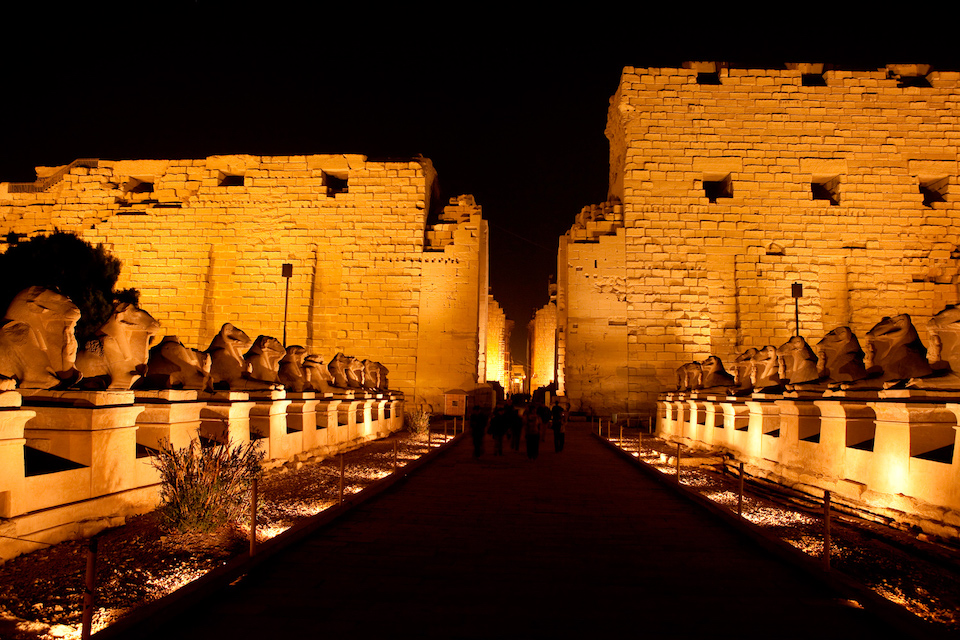
What to pack for a Luxor trip
As you know, I’m a light traveler and packing for a trip like this is an art. Here are some tips on what to prepare for your trip to Luxor:
- Walking Shoes: I love walking around new cities or doing small hikes and so I highly recommend bringing a comfortable pair of shoes on this trip.
- Shirts: It can get quite hot outside when the sun is out and the sky is clear, so be sure to bring plenty of cool shirts.
- Shorts/jeans: Since you will have to travel a lot more while traveling, I strongly recommend bringing some shorts as well as a few jeans to keep it a bit cooler outside. For women, leggings are great for both hot and cold climates, so be sure to bring some.
- Outerwear: An outerwear that is perfect for going outside in the rain or light wind.
- Swimsuit: Swimwear is a must-have item if you are planning to visit Luxor in the summer.
- Camera: It’s also a good idea to bring a good camera for your trip so that you can capture all the beautiful experiences you can have while traveling.
- Portable battery: Make backup power for electronic devices.
- Bottled water: A great insulated water bottle to carry around in the cities or on hiking trails.
- Universal adapter: You only need a universal adapter to plug in your electronic devices in any country you visit.
Some best day tours, trips, activities and transfer services, tickets in, from and to Luxor, Aswan and Cairo you can refer to
- 5-Star Luxury Nile Maxim Dinner Cruise in Cairo
- Historical Alexandria Tour from Cairo
- Private Cairo Airport (CAI) Transfers
- Cairo, Giza Pyramids and Museum Tour from Hurghada
- National Museum of Egyptian Civilization Tour
- Luxury Nile Maxim Dinner Cruise in Cairo
- Luxor City, East and West Bank Tour
- East and West Banks Tour from Luxor
- 2D1N Edfu, Aswan, and Abu Simbel Private Tour from Luxor
- Valley of Kings, Hatshepsut and Karnak Tour from Hurghada
- Private Luxor Airport (LXR) Transfers
Read more Egypt guide here.































![10 best airports in Asia in 2016 [RANKED] kuala-lumpur-international-airport-best airports in asia in 2016 by skytrax ratings](https://livingnomads.com/wp-content/uploads/2016/08/29/kuala-lumpur-international-airport-best-airports-in-asia-in-2016-by-skytrax-ratings-218x150.jpg)








